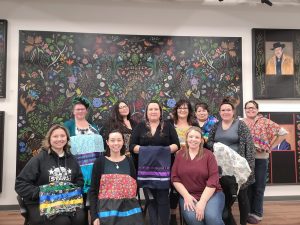News
Ribbon Skirt Teachings
By Randi Ross
Jan 16, 2023
Posted in: Community Building, culture
In 2019, I was fortunate enough to be gifted my first teachings of the ribbon skirt. Prior to these teachings, I was unaware of the history and significance of ribbon skirts; I did not grow up connected to these components of my Métis culture.
My initial learning came through a Métis Ribbon Skirt workshop, offered by Gabriel Dumont Institute (GDI). The workshop facilitators, Bonnie Johnson and Leah Dorion, shared the history of ribbon skirts, including how the prints came to our people, and the meaning behind different patterns and prints. Most recently, the GDI Training and Employment department attended a two-day workshop in the gallery space, facilitated by Amy Briley. The workshop was based on Sînapân Kîskasâkâs: A Guide to Making Contemporary-Style Métis Ribbon Skirts, a publication developed through the institute. Amy used similar instruction, and her own teachings and experiences to provide the education and space to learn.
Learning about the ribbon skirt and hearing stories about their history made me feel proud. The knowledge gained filled in gaps and questions I had lingering in me; I always knew our people were more than sashes and jigging. While those are important, it was really great to learn yet another piece about the Métis peoples’ traditional culture. One lesson that resonated with me most was learning about how ribbon skirts can be referred to as “story skirts”. A skirt can tell you the story of: your family, your personal journey, what makes you feel good, how it helped you heal, or how it honours someone or something. It was said to me the round shape of the skirt represents the cyclical nature of life; and when your skirt touches the ground, it connects you to the earth. Such comments were valuable for me to hear, as they align with my beliefs on the interconnectedness of the earth and its beings. In this way, learning about ribbon skirts is a beautiful way to connect us to our Métis culture. Beyond the cultural teachings, it was great to spend the time with the other Métis women in my department—the entire room was filled with laughter and pride!
Additional teachings have showed me how to make different styles of ribbon skirts for myself (there are so many styles and meanings, it is all so beautiful and interesting!). The most recent skirt I made happens to be a story skirt – it is my birthday skirt. It primarily features the colour red, to represent a personal connection between my father and I. In addition, there is a black ruffle to represent the darkness in mourning, and the light that can come after a period of darkness, as a dedication to those who do not get to have any more birthdays. To finish, I added a blue ribbon, to honour my Métis roots, and a green ribbon, to honour my connection to the earth.
Having the opportunity to take part in these workshops and projects benefits us, as both employees and Métis women, on many levels. For instance, I now have the skill of sewing, which is important to me, and I was able to create something unique to me. The workshops also provided an opportunity to build relationships with my peers, and deepened the knowledge of my culture.
Cultural revitalization is hard work. Unfortunately, art is often dismissed as a means of supporting cultural revitalization. Therefore, it can face obstacles and criticisms in prioritizing its availability. I have pride in my employer for understanding the importance of cultural revitalization – in all of its forms – and for making a variety of opportunities available for everyone to experience; opportunities we would not necessarily have access to otherwise.

